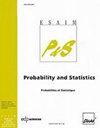Microbial virus epidemics in the presence of contact-mediated host dormancy
IF 0.7
4区 数学
Q4 STATISTICS & PROBABILITY
引用次数: 3
Abstract
We investigate a stochastic individual-based model for the population dynamics of host-virus systems where the microbial hosts may transition into a dormant state upon contact with virions, thus evading infection. Such a contact-mediated defence mechanism was described in Bautista&al. (2015) for an archaeal host, while Jackson-Fineran (2019) and Meeske&al. (2019) describe a related, CRISPR-Cas induced, dormancy defense of bacterial hosts to curb phage epidemics. We first analyse the effect of the dormancy-related model parameters on the probability and time of invasion of a newly arriving virus into a resident host population. Given successful invasion, we then show that the emergence (with high probability) of a persistent virus infection (‘epidemic’) in a large host population can be determined by the existence of a coexistence equilibrium for the underlying dynamical system. That is an extension of a dynamical system considered by Beretta-Kuang (1998), known to exhibit a Hopf bifurcation, giving rise to a ‘paradox of enrichment’. We verify that the additional dormancy component can, for certain parameter ranges, prevent the associated loss of stability. Moreover, the presence of contact-mediated dormancy enables the host population to attain higher equilibrium sizes - and still avoid a persistent epidemic - than hosts without this trait.存在接触介导的宿主休眠的微生物病毒流行
我们研究了一个随机的基于个体的宿主-病毒系统种群动力学模型,其中微生物宿主在接触病毒粒子后可能进入休眠状态,从而逃避感染。Bautista&al描述了这种接触介导的防御机制。(2015),而Jackson-Fineran(2019)和Meeske&al。(2019)描述了一种相关的,CRISPR-Cas诱导的细菌宿主休眠防御,以抑制噬菌体流行。我们首先分析了与休眠相关的模型参数对新到达的病毒入侵常驻宿主种群的概率和时间的影响。在成功入侵的情况下,我们随后表明,在大量宿主种群中出现(高概率)持续病毒感染(“流行病”)可以由潜在动力系统的共存平衡的存在决定。这是Beretta-Kuang(1998)认为的动力系统的延伸,已知表现出Hopf分岔,产生“富集悖论”。我们验证了额外的休眠组件可以,在某些参数范围内,防止相关的稳定性损失。此外,与没有这种特性的宿主相比,接触介导的休眠使宿主种群能够达到更高的平衡规模,并且仍然避免持续流行。
本文章由计算机程序翻译,如有差异,请以英文原文为准。
求助全文
约1分钟内获得全文
求助全文
来源期刊

Esaim-Probability and Statistics
STATISTICS & PROBABILITY-
CiteScore
1.00
自引率
0.00%
发文量
14
审稿时长
>12 weeks
期刊介绍:
The journal publishes original research and survey papers in the area of Probability and Statistics. It covers theoretical and practical aspects, in any field of these domains.
Of particular interest are methodological developments with application in other scientific areas, for example Biology and Genetics, Information Theory, Finance, Bioinformatics, Random structures and Random graphs, Econometrics, Physics.
Long papers are very welcome.
Indeed, we intend to develop the journal in the direction of applications and to open it to various fields where random mathematical modelling is important. In particular we will call (survey) papers in these areas, in order to make the random community aware of important problems of both theoretical and practical interest. We all know that many recent fascinating developments in Probability and Statistics are coming from "the outside" and we think that ESAIM: P&S should be a good entry point for such exchanges. Of course this does not mean that the journal will be only devoted to practical aspects.
 求助内容:
求助内容: 应助结果提醒方式:
应助结果提醒方式:


